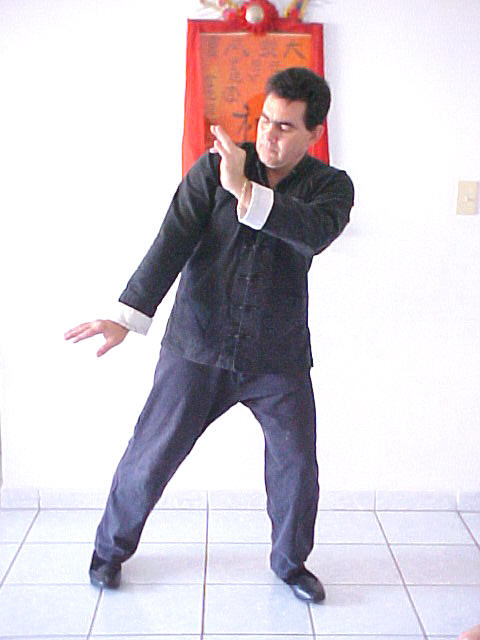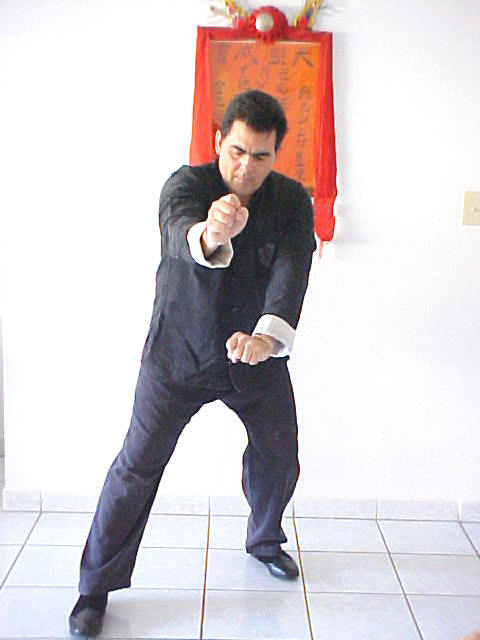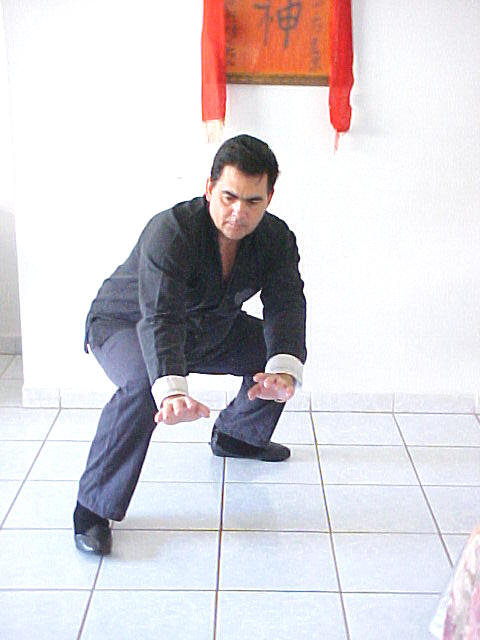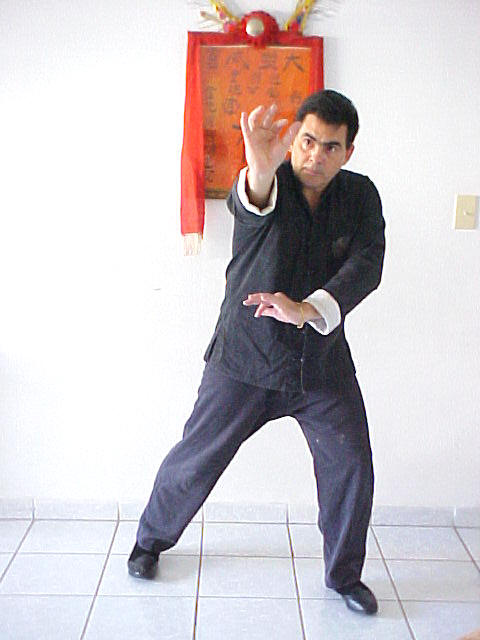BECOMING
EFFECTIVE
SOUTHERN
PRAYING MANTIS FIST
 Gaining
the understanding of the Forms by practicing its moves and visualizing
the purpose of those moves is just the beginning. The practitioner needs
to apply the moves learned from the Forms onto a control fight so that
if and when the time comes, the practitioner may use said moves without
hesitation.
Gaining
the understanding of the Forms by practicing its moves and visualizing
the purpose of those moves is just the beginning. The practitioner needs
to apply the moves learned from the Forms onto a control fight so that
if and when the time comes, the practitioner may use said moves without
hesitation.
First, after learning the Form, it is essential for the practitioner to
select a sequence of moves (7 or more moves) from said Form making the
sequence of moves into one technique. Second, the practitioner
(without a sparring
 partner) will practice that newly developed
technique visualizing the moves being used within an imaginary fight.
This technique is first practiced at a slow pace and slowly increasing
speed as the practitioner becomes more comfortable and proficient
with the moves. Total awareness of the moves, body posture, and balance
is maintained throughout the exercise. Finally, the practitioner begins
to practice this newly acquired technique in a control fight. The
practitioner, during class, when practicing with a sparring partner or
when called to fight in his class, uses only the newly learned technique
concentrating only in the full execution of the technique just as when
the
partner) will practice that newly developed
technique visualizing the moves being used within an imaginary fight.
This technique is first practiced at a slow pace and slowly increasing
speed as the practitioner becomes more comfortable and proficient
with the moves. Total awareness of the moves, body posture, and balance
is maintained throughout the exercise. Finally, the practitioner begins
to practice this newly acquired technique in a control fight. The
practitioner, during class, when practicing with a sparring partner or
when called to fight in his class, uses only the newly learned technique
concentrating only in the full execution of the technique just as when
the
 technique was being practice without a sparring partner. The longer
the practitioner practices the technique with his sparring partner, the
easier it will be for the sparring partner to block and avoid the blows
by the practitioner. The ability of the sparring partner to block or
evades the practitioner's technique, allows the practitioner to increase
the speed and the force of the technique. The selection,
development, proficient execution, and mixing of several techniques by
the practitioner is the fighting goal of a practitioner.
technique was being practice without a sparring partner. The longer
the practitioner practices the technique with his sparring partner, the
easier it will be for the sparring partner to block and avoid the blows
by the practitioner. The ability of the sparring partner to block or
evades the practitioner's technique, allows the practitioner to increase
the speed and the force of the technique. The selection,
development, proficient execution, and mixing of several techniques by
the practitioner is the fighting goal of a practitioner.
It does not matter that the practitioner is not able to "hit" the
sparring
 partner with the execution of any of the techniques. What
matters is the speed, and proper execution of the techniques. When the
practitioner encounters a real threat and uses in defense any of the
techniques previously practiced, execution of the techniques should be
in the same fashion as performed in the school. Only that at such
time, a stranger is in front of the practitioner and not the trained
sparring partner. Rest assure that when properly executed, if the
technique is made up of 7 or more moves, the stranger may be able to
block or avoid 1 or 2 blows of the technique but the rest of the blows
will find its target. This is not to say that the practitioner does not
run the risk of being hit. In a fight, both of the fighters will get
hit.
partner with the execution of any of the techniques. What
matters is the speed, and proper execution of the techniques. When the
practitioner encounters a real threat and uses in defense any of the
techniques previously practiced, execution of the techniques should be
in the same fashion as performed in the school. Only that at such
time, a stranger is in front of the practitioner and not the trained
sparring partner. Rest assure that when properly executed, if the
technique is made up of 7 or more moves, the stranger may be able to
block or avoid 1 or 2 blows of the technique but the rest of the blows
will find its target. This is not to say that the practitioner does not
run the risk of being hit. In a fight, both of the fighters will get
hit.
The key to walk away in victory from a fight is the ability to minimize
the blows and the location of the blows you receive while maximizing the
blows you deliver. We train not to score "hits" on our sparring
partners. We train so that when we face a real threat we are sure
to properly execute our techniques to neutralize or eliminate the
threat. Any other reason given for training is nothing more than an
excuse.
Home
Mastering the Forms
Techniques School
Seminars
Links
Email:
SouthernMantis